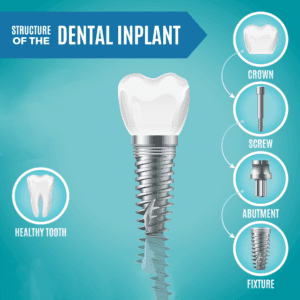If you lose a tooth, you might struggle with the changes in your smile’s appearance and with oral dysfunction. Restore the health and look of your smile after tooth loss with dental implants. These fixtures can fill gaps in your smile and allow you to perform oral functions with ease again.
Though the benefits seem evident, some people worry about receiving fixtures in their mouths. To boost your confidence in this tooth replacement solution, it can help to learn more about these fixed oral appliances. Read on to find details about the three major parts that make up your dental implant and how they contribute to the function of this device.

Anchor
When you and your dentist decide to pursue tooth replacement through implant dentistry, the initial step involves oral surgery. The dentist will place the first part of the dental implant, the titanium post anchor, into the jaw. In this one procedure, you can receive as many anchors as you require to fully restore your smile with implants.
This base of the implant fuses with the bone in the jaw to ultimately support the rest of the device. It will take several months for this process to take place and for you to heal properly from this procedure.
The anchor also serves as a replacement for the missing root of the lost tooth, a feature that removable treatments like dentures cannot accomplish. This added benefit allows for protection of the jawbone, which can deteriorate without stimulation from a tooth root or adequate substitute.
An implant relies heavily on the fusion of this anchor with the jaw. So your dentist will need to check your jawbone health to ensure this process can occur successfully. If you lost too much bone in the jaw in the wake of tooth loss, you might not be able to sustain an implant. In this case, a dentist might suggest a bone graft or other dental solution to build structure in the jaw.
Abutment
Atop the anchor of your dental implant on the gumline, you will receive an abutment. This connective fixture serves as a point that will ultimately attach the prosthetic teeth to the anchor of your appliance.
The extra security of the fit of your fixtures with this component will ensure you do not have to worry about the implant slipping out of place at an inopportune moment. You can see the full restoration of oral function and your smile’s appearance with the utmost confidence.
Dental Prosthetic
The final component of your dental implant is the prosthetic device. These synthetic teeth will replace one, several, or a full arch of teeth using a crown, bridge, or denture appliance, respectively.
Dentists build these prosthetic teeth on a custom basis, so you can trust that the dentist will make these teeth gorgeous, comfortable, and natural-looking. They resist staining and decay, so you can ensure the aesthetic and restorative benefits will last a long time. They can remain in place for twenty years or longer with proper care.
